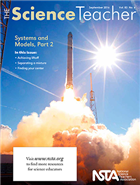Using Web Tools to Support Learning
Standards play an important role in developing a strong curriculum and preparing students for the future. Science teachers are currently adjusting their curriculum to meet the Next Generation Science Standards, but other standards can also help us as the line between science and other subjects blurs.
The ISTE standards
The International Society for Technology in Education (ISTE) Standards for Students were originally published in 1998 under the name of the National Education Technology Standards. The standards emphasized technology as tools and required students to demonstrate proficiency with the tools.
Nine years later, in 2007, ISTE released an updated version of the standards that focused on how students use technology and moved away from simply learning about technology tools. They aspired to demonstrate such student behaviors as Creativity and Innovation, Communication and Collaboration, and Critical Thinking.
Now, ISTE has once again updated the Standards for Students. The new standards, released in June, look at how technology amplifies learning. They address the following student roles: Empowered Learner, Digital Citizen, Knowledge Constructor, Innovative Designer, Computational Thinker, Creative Communicator, and Global Collaborator.
Improved classroom activities
The 2007 revision of the ITSE standards made us rethink the skills students should be able to demonstrate upon graduation. We began to develop activities that combined one or more of the standard areas with curricular goals. At the time of their release, Ben Smith, co-author of this column, had an activity published by ISTE that required his physics students to make a video of some type of motion, analyze the motion with software, and publish their results on a website. Ben’s students learned how to use iMovie and VideoPoint and to create a website using Inspiration and Word. This multifaceted assignment was a great way to use standards to assess student skills.
Another assignment enhanced by the standards was Ben’s amusement park physics project. In earlier days, students simply took measurements while riding on amusement park rides and calculated experimental values. At the end of the day, they turned in a packet of papers to provide evidence for these calculations and perhaps performed some analysis.
In light of the evolving standards, students were next asked to become experts on just one ride and communicate how the ride works. They were assessed on creativity and ability to collaborate with peers and communicate their findings. This led to many different types of submissions. For instance, one group created a podcast while riding a roller coaster, explaining the physics behind the ride.
As technology developed, students created new formats for completing their work. Nowadays, they can even use apps for instant video analysis and for the collection of acceleration and motion data. Some use presentation tools while others make movies, websites, or other products with specific web 2.0 tools.
This year, students tweeted about physics experiences during the park visit. They used the hashtag #rlphun (RL for Red Lion and Phun for the class slogan “Physics is Phun”) as they gave a brief description of the activity and included a hashtag for the instructional unit (e.g., #momentum, #circular, and #newtons1st).
Conclusion
We are inspired by the actionable nature of the ISTE standards and the emphasis on student behaviors. These standards naturally fit with the NGSS as well as science, technology, engineering, and math (STEM) and science, technology, engineering, art, and math (STEAM) curricula. In coming issues, we will take a deeper dive into the tech standards and discuss what they may look like in a transformed science classroom.
Ben Smith is an educational technology program specialist, and Jared Mader is the director of technology, for the Lincoln Intermediate Unit in New Oxford, Pennsylvania. They conduct teacher workshops on technology in the classroom nationwide.
Editor’s Note
This article was originally published in the September 2016 issue of The Science Teacher journal from the National Science Teachers Association (NSTA).
Get Involved With NSTA!
Join NSTA today and receive The Science Teacher, the peer-reviewed journal just for high school teachers; to write for the journal, see our Author Guidelines and Call for Papers; connect on the high school level science teaching list (members can sign up on the list server); or consider joining your peers at future NSTA conferences.
The mission of NSTA is to promote excellence and innovation in science teaching and learning for all.



 My principal asked me to be a mentor for a new science teacher. I received a checklist of high school policies to review, but how can I help him in other ways? – T., New Jersey
My principal asked me to be a mentor for a new science teacher. I received a checklist of high school policies to review, but how can I help him in other ways? – T., New Jersey